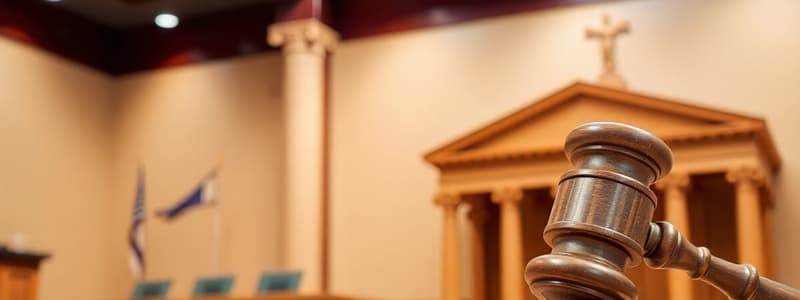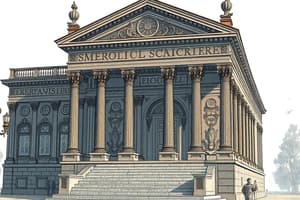Podcast
Questions and Answers
What is meant by 'judicial activism'?
What is meant by 'judicial activism'?
- A broader interpretation allowing judges to expand rights (correct)
- A strict interpretation of the Constitution to limit government power
- A reliance solely on legislative intent in court rulings
- A refusal to apply precedent in decision making
What does 'writ of certiorari' signify in the judicial process?
What does 'writ of certiorari' signify in the judicial process?
- A written opinion by a judge outlining their reasoning
- A formal request for legislation to be reviewed by the court
- An order for a lower court to send records for review (correct)
- A statement issued by the Solicitor General regarding cases
Which of the following best describes 'original jurisdiction'?
Which of the following best describes 'original jurisdiction'?
- The ability to rule on constitutional matters
- The power to hear a case for the first time (correct)
- The capacity to enforce federal laws specifically
- The authority to review decisions made by lower courts
What is the 'Rule of Four' in the context of the Supreme Court?
What is the 'Rule of Four' in the context of the Supreme Court?
Who were the first African American and female justices appointed to the Supreme Court?
Who were the first African American and female justices appointed to the Supreme Court?
Flashcards
Judicial review
Judicial review
The power of the courts to declare laws unconstitutional.
Writ of Certiorari
Writ of Certiorari
An order by a higher court to review a lower court's decision.
Plaintiff
Plaintiff
The person or party who brings a lawsuit.
Precedent
Precedent
Signup and view all the flashcards
Jurisdiction
Jurisdiction
Signup and view all the flashcards
Study Notes
Judicial Branch Study Guide
- Dissenting Opinion: A written statement disagreeing with the majority opinion in a court case.
- Concurring Opinion: A written statement agreeing with the majority opinion but with different reasoning.
- Writ of Certiorari: An order from a higher court to a lower court to send up the records of a case for review.
- Judicial Review: The power of courts to declare laws unconstitutional.
- Briefs: Written documents presenting arguments to a court.
- Plaintiff: The party initiating a lawsuit.
- Defendant: The party being sued.
- Precedent: A court decision that guides future similar cases.
- Judicial Activism: A judicial philosophy that actively shapes laws and policies.
- Judicial Restraint: A judicial philosophy that avoids creating new laws or policies.
- Criminal Case: A legal case involving a crime.
- Civil Case: A legal case involving a non-criminal dispute.
- Jurisdiction: The power of a court to hear and decide a case.
- Original Jurisdiction: The power of a court to hear a case for the first time.
- Appellate Jurisdiction: The power of a court to review decisions of lower courts.
Multiple Choice Topics
- Steps to Become a Federal Judge: Process for becoming a federal judge is not detailed here.
- Supreme Court Size: The number of Supreme Court justices is determined by Congress, and not set in the constitution.
- Current Number of Supreme Court Justices: The current number is not given.
- District Courts: Trial courts in the federal court system.
- Court of Appeals: Intermediate appellate courts in the federal system.
- Presidential Nomination Criteria: The factors a president considers when nominating a federal judge are not detailed. .
- Federal Judge Term Length: Federal judges serve for life.
- First Female Supreme Court Justice: The specific name is not provided, only the fact.
- First African American Supreme Court Justice: The name is not provided, only the fact.
- Article III: Refers to the article in the US constitution dealing with the judicial branch.
- Senatorial Courtesy: A process where senators from the president's party can influence judicial appointments in their state.
Additional Information (Page 2)
- Supporters of Judicial Restraint: Individuals who favor a more limited role for the Court in shaping policy.
- Supporters of Judicial Activism: Individuals who favor an active role for the Court in shaping policy.
- Cases Sent vs. Heard: The number of cases sent to the Supreme Court and those they choose to hear.
- Solicitor General: A Presidential appointee who argues cases before the Supreme Court.
- "Rule of Four": a Supreme Court rule requiring at least four justices to agree to hear a case.
- Marbury v. Madison: The landmark case establishing judicial review.
- Senate Judiciary Committee: The committee in the Senate that holds hearings for judicial nominations.
- Judicial Implementation: The process by which courts' decisions are put into effect.
- Amicus Curiae (Amicus briefs): Supporting briefs filed by non-parties in a case.
- Stare Decisis: The principle of adhering to precedents.
Studying That Suits You
Use AI to generate personalized quizzes and flashcards to suit your learning preferences.




